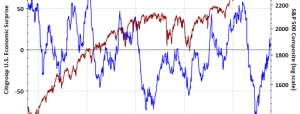The Warning Of Imports/Exports
At the beginning of 2015, I noted the divergence between the ISM manufacturing survey and the decline in both imports and exports. To wit:
“The surging dollar and weak consumer demand are also being reflected in import and export activity.”
The importance of the chart above was the divergence between the “sentiment based”ISM survey’s and actual economic data. The suggestionthen was that the surveys were going to play catch up to the actual economic activity and not vice-versa. I have updated the chart above to show you that has been exactly the case despite much mainstream commentary to the contrary.
While the surging U.S. dollar has provided a substantial drag on EXPORTS, it certainly does not explain the sharp decline in IMPORTS which should benefit by being cheaper for domestic consumers. It is also quite the conundrum when combined with the fall in gasoline prices that, as ALL mainstream economists believed, would provide an additional boost to consumption. (See “Falling Energy Costs and Economic Impacts” for why it did not occur.)
The decline in both exports and imports is evidence that the underlying economic strength has deteriorated sharply in recent months. Note, in the chart below, both the annual rate of change in imports and exports have now moved into negative territory.Importantly, both (on an annual percentage change basis) have now fallen below -5%. Historically, this has been coincident with the onset of previous recessionary periods. The extremely sharp decline in imports suggest, despite lower gasoline prices, the contraction in domestic spending is much sharper than currently realized.
Economic Confidence Takes A Hit
The contraction in both exports and imports is the hard data behind the economy. In the short-term confidence, or sentiment, can remain elevated as individuals and businesses“hope” that recent activity will continue. Such psychological tendencies are termed“recency bias,” which is when very recent events are extrapolated into the future.










